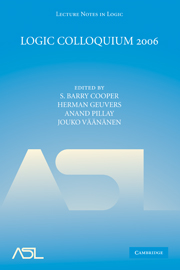Book contents
- Frontmatter
- Contents
- Introduction
- Definability and elementary equivalence in the Ershov difference hierarchy
- A unified approach to algebraic set theory
- Brief introduction to unprovability
- Higher-order abstract syntax in type theory
- An introduction to b-minimality
- The sixth lecture on algorithmic randomness
- The inevitability of logical strength: Strict reverse mathematics
- Applications of logic in algebra: Examples from clone theory
- On finite imaginaries
- Strong minimal covers and a question of Yates: The story so far
- Embeddings into the Turing degrees
- Randomness—beyond Lebesgue measure
- The derived model theorem
- Forcing axioms and cardinal arithmetic
- Hrushovski's amalgamation construction
The derived model theorem
Published online by Cambridge University Press: 28 January 2010
- Frontmatter
- Contents
- Introduction
- Definability and elementary equivalence in the Ershov difference hierarchy
- A unified approach to algebraic set theory
- Brief introduction to unprovability
- Higher-order abstract syntax in type theory
- An introduction to b-minimality
- The sixth lecture on algorithmic randomness
- The inevitability of logical strength: Strict reverse mathematics
- Applications of logic in algebra: Examples from clone theory
- On finite imaginaries
- Strong minimal covers and a question of Yates: The story so far
- Embeddings into the Turing degrees
- Randomness—beyond Lebesgue measure
- The derived model theorem
- Forcing axioms and cardinal arithmetic
- Hrushovski's amalgamation construction
Summary
We shall exposit here one of the basic theorems leading from large cardinals to determinacy, a result of Woodin known as the derived model theorem. The theorem dates from the mid-80's and has been exposited in several sets of informally circulated lecture notes (e.g., [11, 14]), but we know of no exposition in print. We shall also include a number of subsidiary and related results due to various people.
We shall use very heavily the technique of stationary tower forcing. The reader should see Woodin's paper [13] or Larson's [3] for the basic facts about stationary tower forcing. The second main technical tool needed for a full proof of the derived model theorem is the theory of iteration trees. This is one of the main ingredients in the proof of Theorem 3.1 below, but since we shall simply take that theorem as a “black box” here, it is possible to read this paper without knowing what an iteration tree is.
The paper is organized as follows. In §1, we introduce homogeneity, weak homogeneity, and universal Baireness. The main result here is the Martin- Solovay theorem, according to which all weakly homogeneous sets are universally Baire. We give a reasonably complete proof of this theorem. In §2 and §3, we show that in the presence of Woodin cardinals, homogeneity, weak homogeneity, and universal Baireness are equivalent. We also give, in §3, an argument of Woodin's which shows that strong cardinals yield universally Baire representations after a collapse.
- Type
- Chapter
- Information
- Logic Colloquium 2006 , pp. 280 - 327Publisher: Cambridge University PressPrint publication year: 2009
- 12
- Cited by



